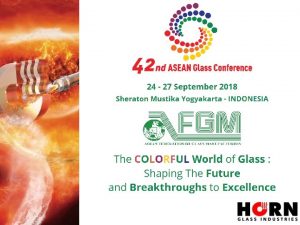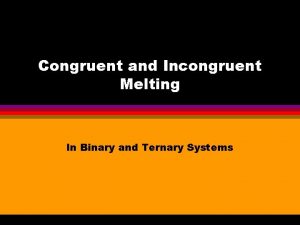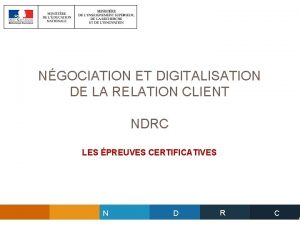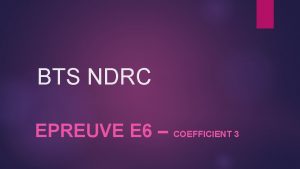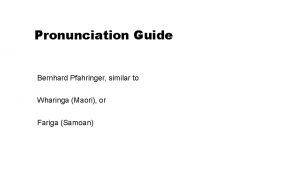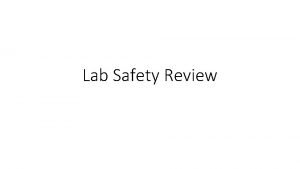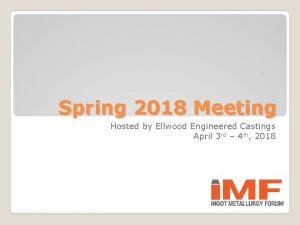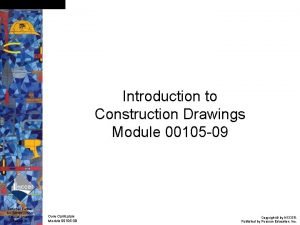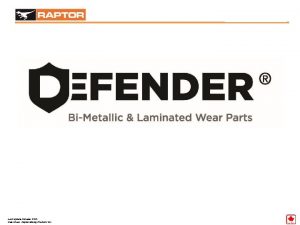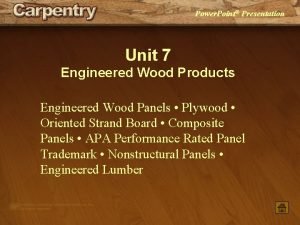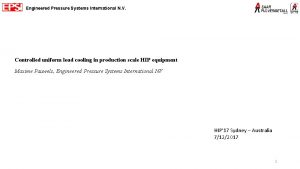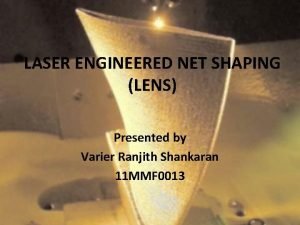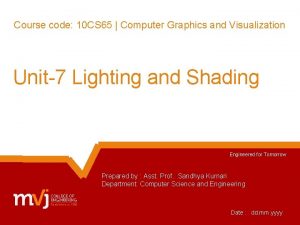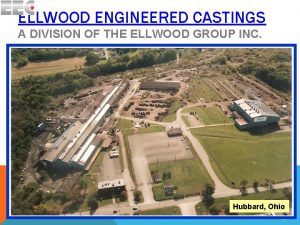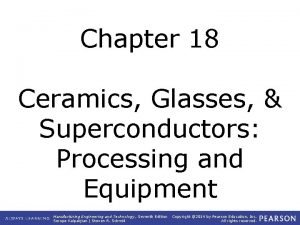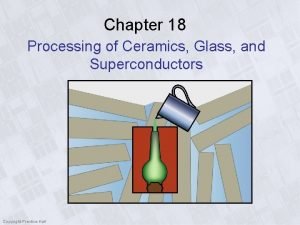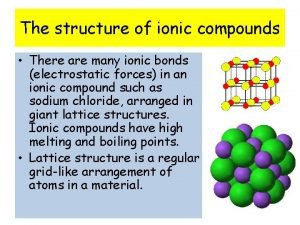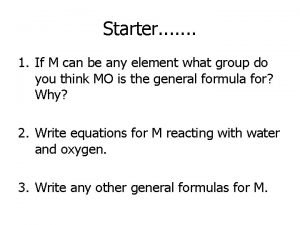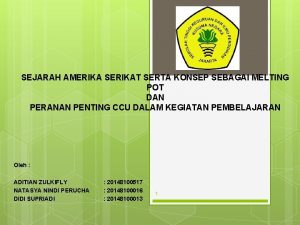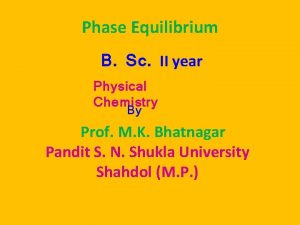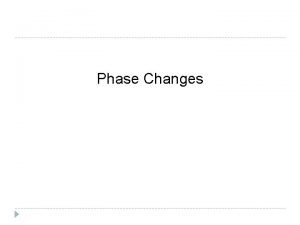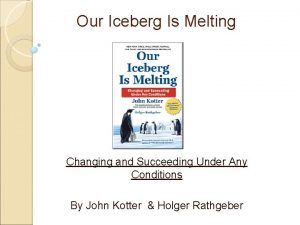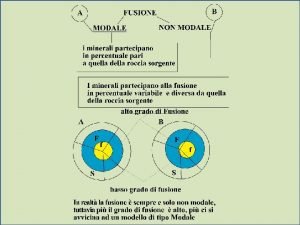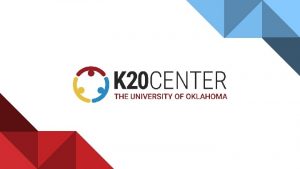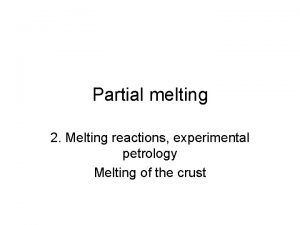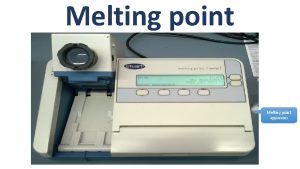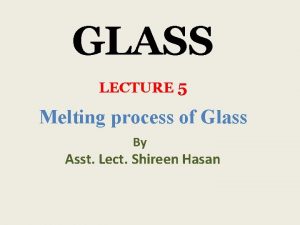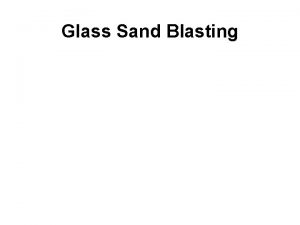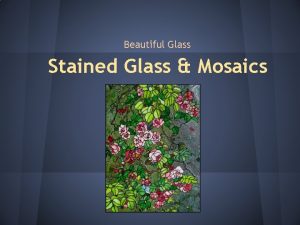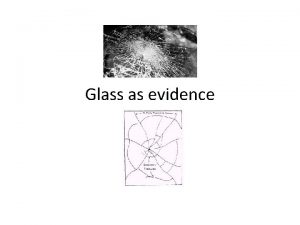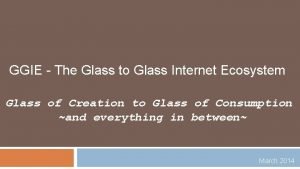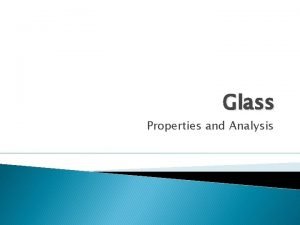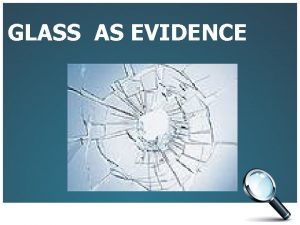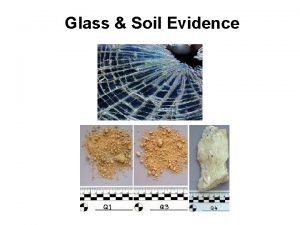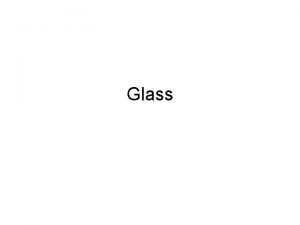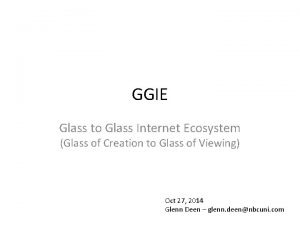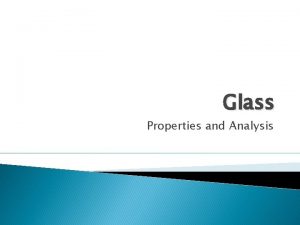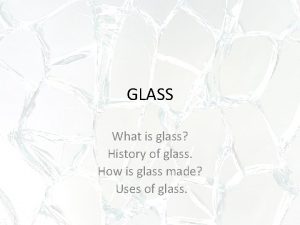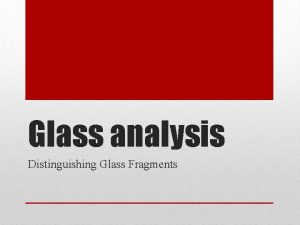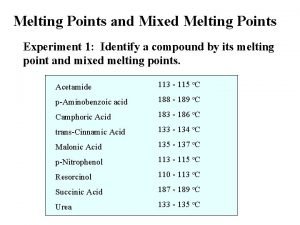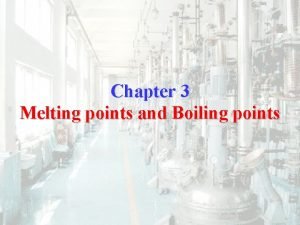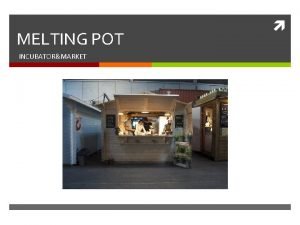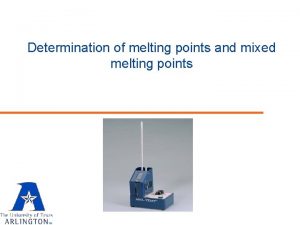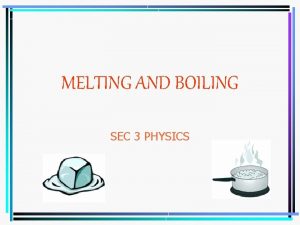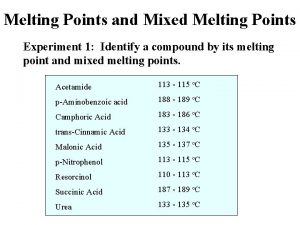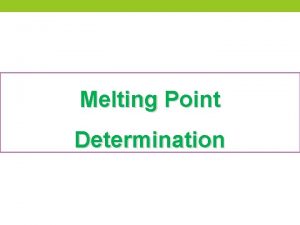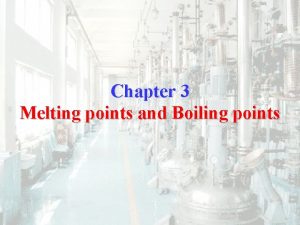ENGINEERED IN GERMANY Digitalisation of Glass Melting Process






























- Slides: 30

ENGINEERED IN GERMANY

Digitalisation of Glass Melting Process ___ Possibilites and Limitations – is the ‘Glass Furnace 4. 0‘ possible ? – Lecturer: Ulrich Imhof HORN Glass Industries AG Bergstrasse 2 95703 Ploessberg / Germany 2 ENGINEERED IN GERMANY

CONTENT 1. Introduction 2. Sensors & Actuators in Container Glass Production 3. Current Control loops and Control Strategies 4. New Requirements / Future needs 5. Predictability of Glass Melting / conditioning process 6. Data transfer and – evaluation – ‘cyber maintenance’ 7. Future outlook 3 ENGINEERED IN GERMANY

1. Introduction - Big discussion about ‘Industry 4. 0’. Machines & Software beeing developped in many areas of the Manufacturing process. - Basis of digitalisation is sensor-based collection of data - Problems in Glass making: Extreme Temperature ”unexplored” chemical melting process huge number of dependences for any result (e. g. Blister investigation) long reaction times collection of data more difficult than in other industries lack of experienced personnel 4 ENGINEERED IN GERMANY

1. Introduction Proper sensors necessary Interaction of currently rather distinct production areas Batch House Furnace Forehearth IS-Machine Inspection Machines 5 ENGINEERED IN GERMANY

2. Sensors & Actuators – Melting End Necessary Sensors for Glass Melting – Bare Minimum • • • 6 1 direct thermocouple in crown 1 -2 indirect thermocouple in crown 2 -3 indirect thermocoules in bottom 1 furnace pressure probe 1 gas amount measurement No/low limitation of: • Emissions (NOx, CO, SOx) • Energy consumption • Glass quality ENGINEERED IN GERMANY

2. Sensors & Actuators – Melting End Necessary Sensors for Glass Melting incooperating limitations for Emissions, Energy and Glass Quality • • • • 7 1 direct thermocouple in crown 4 indirect thermocouples in bottom 1 direct thermocouple in riser 2 furnace pressure probes (backup) 1 chimney draft measurement 1 fuelflow meter (port control) (1 fuelflow meter each burner or nozzle) 1 airflow meter 2 direct thermocouple at top of regenerator 2 oxygen probe at top of regenerator 1 -2 Glass level measurement Furnace camera Measuring devices for electric boosting Process Control System (PCS) TC Crown TC Bottom ENGINEERED IN GERMANY

2. Sensors & Actuators – Melting End Necessary Sensors for Glass Melting incooperating limitations for Emissions, Energy and Glass Quality Additional Sensors / Tools for Functional Safety: • Safety control system CPU • Redundant airflow measurement device/transmitter • Redundant furnace pressure transmitter • Redundant direct crown transmitter Certified sensors are neccesary! There is a lot of effort necessary to maintain a good, stable and safe process! 8 ENGINEERED IN GERMANY

2. Sensors & Actuators – Distr. / FH Necessary Sensors for Conditioning – Bare Minimum • 1 direct thermocouple in glass each zone of distributor and forehearth • 1 pressure probe fuel each zone Combustion airflow and cooling dampers can be adjusted manually Very time consuming Very much experience necessary (visual adjustment) No measuring of homogeniety 10 ENGINEERED IN GERMANY

2. Sensors & Actuators – Distr. / FH Necessary Sensors for Conditioning - For many Job Changes, Reproducibility and high homogeniety • 1 direct thermocouple each zone of distributor • 1 direct triple thermocouple each zone of forehearth • 3 direct triple thermocouple each zone of forehearth • 1 pressure sensor fuel each zone • Ratio control valve each zone • Combustionair flow measurement • Coolingairflow (in-)direct cooling • (remote control dampers with positioning sensor) • (Lambda-Control by residual O 2 measurement) 11 ENGINEERED IN GERMANY

3. Current Control Loops – Dist. / FH Control Loops Distributor / Forehearth • Temperature control • Cooling Air Control Advanced Control Systems Distributor / Forehearth • Integrated forehearth control (simultaneous control of combustion and cooling) • Setpoint Slope • Lambda Control Model Predictive Control Systems Distributor / Forehearth • Self optimizing • Not very common yet 14 ENGINEERED IN GERMANY

3. Current Control Loops – Dist. / FH Standard Control Strategy Manual setting • Cooling Fans (regulation flap or frequency converter) • cooling dampers / chimneys (manually or with actuators) • Fuel/combustion air ratio Temperature Control • Affects combustion only • Supporting tools like setpoint slope 15 ENGINEERED IN GERMANY

3. Current Control Loops – Dist. / FH Advanced Control Strategy – Integrated Control Integrated Temperature Control • Affects combustion, cooling fans and dampers • Combustion is in a defined range (optimum 15 - 25 mbar) • Cooling is used to cool down and keep combustion in optimum range • PID – temperature controller sends signal to PCS module. For every actuator exists a predefined control curve 16 ENGINEERED IN GERMANY

3. Current Control Loops – Strategy Advanced Control Strategy – Cascade Control Loops Manual setting • Gob weight pull • Cut number • Gob viscosity forming process Gob temperature is calculated from batch house data All temperatures before adjusted with integrated control Possibly even optimum distributor entrance temperature is adjusted in the melting end Feedback from inspection machines for ? m a - IS – Machine settings (shape) re d fa - Batch house (color) o ind k s - Melting end (glass quality) is i Th 17 ENGINEERED IN GERMANY

3. control loops / control strategy Defect sourcing /starting from cold end Glass Tentry Gob (T; THI; viscosity) defects mostly have reverse origin co for ol mi in ng g / Hot End Inspection Cold End IS-Machine “old saying”: Half of the bottle is produced In the Forehearth 18 Annealing Lehr ENGINEERED IN GERMANY

3. control loops / control strategy Good Production Time Gain with Cascade Control Loop Fully controlled FH - Reaction time: - Feeder EQZ Zone x – (a+b+c+d) - Drop from spout x – (a+b+c) - IS - Machine x – (a+b) - cooling lehr x–a - cold end inspection x (= time when defect is found) Gob inspection machine Hot inspection machine Long time between action and reaction. Too long for efficient production! Hot or gob inspection machines or fully controlled forehearth necessary ( “detects” defect source in conditioning before it occurs at spout) 19 ENGINEERED IN GERMANY

4. Future needs General Aspects of Industry 4. 0 Prerequsites: • Process description • Interlinkage of data • Data base Invest and Specialists Automatic Process Control is not free of maintenance • Self-learning is not automatic (has to be adjusted and checked – setpoints, priorities, restrictions) • Model predictive control (MPC) Predicative Maintenance for stable process operation • Checks • Exchange of wear parts Structures have to be organized • Documetation 20 ENGINEERED IN GERMANY

4. Future needs Control Aspects to improove Goals: • Faster reaction time for less production loss • More precise regulation for optimum performance • Less manpower for more time for innovation • Same control strategy for the whole day for stability Solutions • More control loops • Self optimizing systems • Interlinkage between single production units Tools • More Sensors for better resolution? • Better Sensors for higher accuracy? • Different Sensors for additional information? • More sophisticated control methods / algorithms? 21 ENGINEERED IN GERMANY

4. Future needs Measures to improve Control Aspects • More Sensors for better resolution? - Grid measurement • Better Sensors for higher accuracy? - lower measuring failure - lower drift over time, e. g. pyrometer • Different Sensors for additional information? - direct temperature measurement in melting end - redox probe in glass - faster reaction time due to earlier information • More sophisticated control methods - Energy balance based control - CFD Model based control • Interlinkage between single production units 22 Higher cost Mostly use of available tools ENGINEERED IN GERMANY

4. Future needs Possible New/Advanced Sensors for Glass Melting • REDOX probe in glass High cost for short lifetime • SOx Sensor in glass • Natural Gas analyser (to be able to react on fuel quality changes) expensive • Flue gas analyser (Laser type in port neck or extractive for complete analysis) expensive and high maintenance • Thermographic camera only sensible with combustion optimization • More direct thermocouples in glass (for faster reaction time) weak point of furnace structure • Hot end inspection machine for faster reaction time Probably information can be gathered elsewhere in process. E. g. from distributor/forehearth (e. g. temperature) or inspection machines (e. g. redox by color analysis or melting temperature by seedcount) 23 ENGINEERED IN GERMANY

4. Future needs Possible New/Advanced Actuators for Glass Melting End • Automatic burner angle adjustment • Additional injection lances of air, natural gas or oxygen (gg. ENOx, COROX, counter air at port neck) • Automatic insulation removal / mounting (e. g. in refining part) Distributor Forehearth • Active cooling elements • Automatic insulation removal / mounting • Automatic adjustment of residual O 2 24 ENGINEERED IN GERMANY

4. Future needs Available or Possible Advanced Control Systems Melting End • Model Predictive Control Distributor Forehearth • Model Predictive Control • Integrated temperature control • Cascade temperature control (setpoint is at the end of production chain, all other zones are subordinated and automatically adjusted) 25 ENGINEERED IN GERMANY

4. Future needs Possible Links between distinct Production Steps Melting End Batch House Energy consumption Batch humidity Cullet content Sulphate/Carbon amount Foam on the furnace 26 Inspection Machine Batch House Color (de)coloring agent, Redox Inspection Machine Furnace Glass Quality Energy consumption Inspection Machine Forehearth Bottle Shape Setpoint gob temp ENGINEERED IN GERMANY

5. Predictability of Glass melting / conditioning process Glass Melting is a complex process and can be predicted by: • Energy balance models • Mathematical approximations (only valid for one furnace at one time) • Complete CFD Model • Experience Glass Quality Raw Materials Cullet Energy Batch humidity Mixing Time Combustion 27 Weather ENGINEERED IN GERMANY

5. Predictability of Glass melting / conditioning process Energy Balance Model of Melting End All numbers are known or easy to calculate: • Fuel in – known • Boosting in – known • HR Glass - calculate • Flue out – calculate • Glass out – calculate • Heatloss – residue • Batch in - neglible • Air in - neglible Heatloss Glass out Fuel in HR Glass Boosting in Greatest uncertainities: • Cp value of glass • Reaction enthalpy of glass (also batch humidity) 28 Flue out ENGINEERED IN GERMANY

5. Predictability of Glass melting / conditioning process Energy Balance Model of Conditioning Process Is currently not used forehearth control, but forehearth design. Easier than furnace model, but no information about essential output: Homogeniety Cooling Flue out Fuel in Heatloss Glass out Glass in Boosting in Needs to be connected with restrictions and probably self optimizing algorithms, possibly feasible for energy control, but not for homogenisation 30 ENGINEERED IN GERMANY

5. Predictability of Glass melting / conditioning process Model Predictive Control To develop a working totally predictive model is very time consuming and needs a lot of data. Since every furnace is different, it has to be adjusted to the circumstances. 31 ENGINEERED IN GERMANY

6. Data Transfer and evaluation Cyber Maintenance is already reality for - Software (PCS) - Failure diagnosis (e. g. pushing of electrodes, or batch charger failure) Data is already transfered • Via internet and VPN or Team Viewer to another client • Via wireless LAN to cell phones/tablets in plant There are little robots for mechanical work, though robot number is increasing rapidly: - Swabbing robots - Inspection machines - Packaging machines Probably some machines will be equipped self repairing/saving systems, e. g. a batch charger that can pull out itself in case of clogged funnel. Most probably these special activities will be done still by humans 32 ENGINEERED IN GERMANY

7. Future outlook / conclusion Many companies are working on self conducting and optimizing processes. Every stupid and hard work will be done more and more by robots and employees have to cope with totally different problems than today. The fourth industrial Revolution will lead to • • • 33 More sensors More actuators (robots) Other qualification needs for employees Less physical work and more brainwork Different company structures ENGINEERED IN GERMANY

THANK YOU FOR YOUR ATTENTION! 34 ENGINEERED IN GERMANY
 Engineered in germany
Engineered in germany Congruent melting compound
Congruent melting compound Thème étude réflexive
Thème étude réflexive Exemple étude réflexive ndrc
Exemple étude réflexive ndrc Pronunciation
Pronunciation Glass ceiling vs glass escalator
Glass ceiling vs glass escalator If acid is splashed on your skin wash at once with
If acid is splashed on your skin wash at once with Does hot glass look like cold glass
Does hot glass look like cold glass Engineered castings
Engineered castings In the alphabet of lines an area not included
In the alphabet of lines an area not included Nccer introduction to construction drawings
Nccer introduction to construction drawings Engineered wear products
Engineered wear products Engineered wood products unit 7
Engineered wood products unit 7 Engineered pressure systems
Engineered pressure systems Lens laser engineered net shaping
Lens laser engineered net shaping Engineered shading
Engineered shading Ellwood engineered castings
Ellwood engineered castings Glass tube manufacturing process
Glass tube manufacturing process Glass tube manufacturing process
Glass tube manufacturing process Ionic solids brittle
Ionic solids brittle Reactivity group 1
Reactivity group 1 Flame colours of group 2 elements
Flame colours of group 2 elements Meaning of melting pot of cultures
Meaning of melting pot of cultures Oxbridge melting pot
Oxbridge melting pot Define congruent melting point
Define congruent melting point Phase changes
Phase changes Melting point of group 2
Melting point of group 2 Our iceberg is melting exercises
Our iceberg is melting exercises Batch melting formula
Batch melting formula Non metals melting and boiling points
Non metals melting and boiling points United states salad bowl
United states salad bowl
